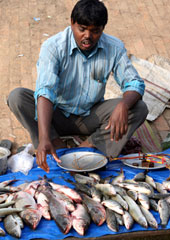Dateline India: The Fishmongers of South Delhi
In India, the daily interchange between fishmonger and buyer is one way to overcome basic social differences.
December 29, 2011

I hail from West Bengal in India, a state that prides itself on great poetry, intellectualism and a strong anti-establishment streak. (For evidence of the latter, look no further than the fact that we had a Communist Party for many years after the fall of the Berlin Wall — yes, Cuba, North Korea and West Bengal.)
In addition, Bengalis share a great passion for two distinctly different types of food — cloying sweets and fish. We even have fish-shaped sweets — that’s how much we love both types of foods. True Bengali fish connoisseurs spend a significant portion of their day evaluating, purchasing, discussing, preparing, cooking and eating fish.
Nowhere is this more true than in Chittaranjan Park, which is a Bengali enclave in South Delhi. Chittranjan Park was created as a refuge for Bengalis displaced during the 1971 India/Pakistan War. If you could prove that your family had lost land in what was now the new formed state of Bangladesh, the Indian government took pity on you and gave your family subsidized land in the middle of South Delhi.
And Bengalis, being what they are, went about in fairly short order building sweet shops and a big open-air fish market on the fringes of the Chittaranjan Park colony. The open-air market is comprised of long narrow stalls of fishmongers, each peddling his wares and working hard to convince each and every passerby to purchase his or her daily share of the finest catch from the seas, rivers and lakes of India.
Bengalis, who are known to be discriminating and opinionated about most things, are particularly opinionated about fish. There is a whole ritual to purchasing fish. First, you need to see if their eyes are glassy, which indicates freshness.
Then, you need to check behind the gills to see signs of redness, which indicates blood has recently been coursing through the body of the fish. Then you have to feel the textures of the scales — not too slimy, not too sharp.
And last but certainly not least, there is a thorough interrogation of the fishmonger, peppering him with questions about whence the fish came, whether it arrived by rail or road, whether it had been packed in ice, and the like.
After the evaluation and selection process comes the negotiation. Thirty rupees a kilo? Outrageous! Was the fish bathed in fresh water from the Ganges River and carried over on a gold-leaf rail carriage? Buyers feign indignation at the price and begin to walk away.
This then prompts the fishmonger to begin the groveling process, cajoling the customer back, besieging them to take another look at the lovely fish, apologizing profusely for the price, but after all, the fishmonger has a family to feed — and would 20 rupees a kilo be too much to ask?
For a long time, I found this back-and-forth to be particularly counter-productive. After all, why bother with the banter? Why not just settle on the original price — and ditch the histrionics?
It wasn’t until I was much older that I realized the joy and delight came, in fact, from the daily human interaction.
In a society where caste, religion, culture, region, race and gender create so many real and conceived barriers, the daily interchange between the fishmonger and the buyer is one way to overcome these basic differences and share in a common exchange. Perhaps it is one way to create an equilibrium and equality in an inherently unequal environment.
Viewed through that lens, the fish market in Chittaranjan Park is no different than any le marché in the Provence where one buys baguette and cheese, or the numerous farmers markets that have dotted the American urban landscape over the past ten years as part of the growing “local food” movement.
The desire to feel that we are closer to our food is, to a certain degree, a desire to be closer to the individuals who produce the food. It reflects a desire for basic human reconnection across borders and social barriers.
From the personal stories we hear from the vendors, to the sheer delight in telling the story to family and friends, about how you negotiated a great price — these daily market exchanges lay the foundation for how strangers become friends, for what makes us part of our community.
